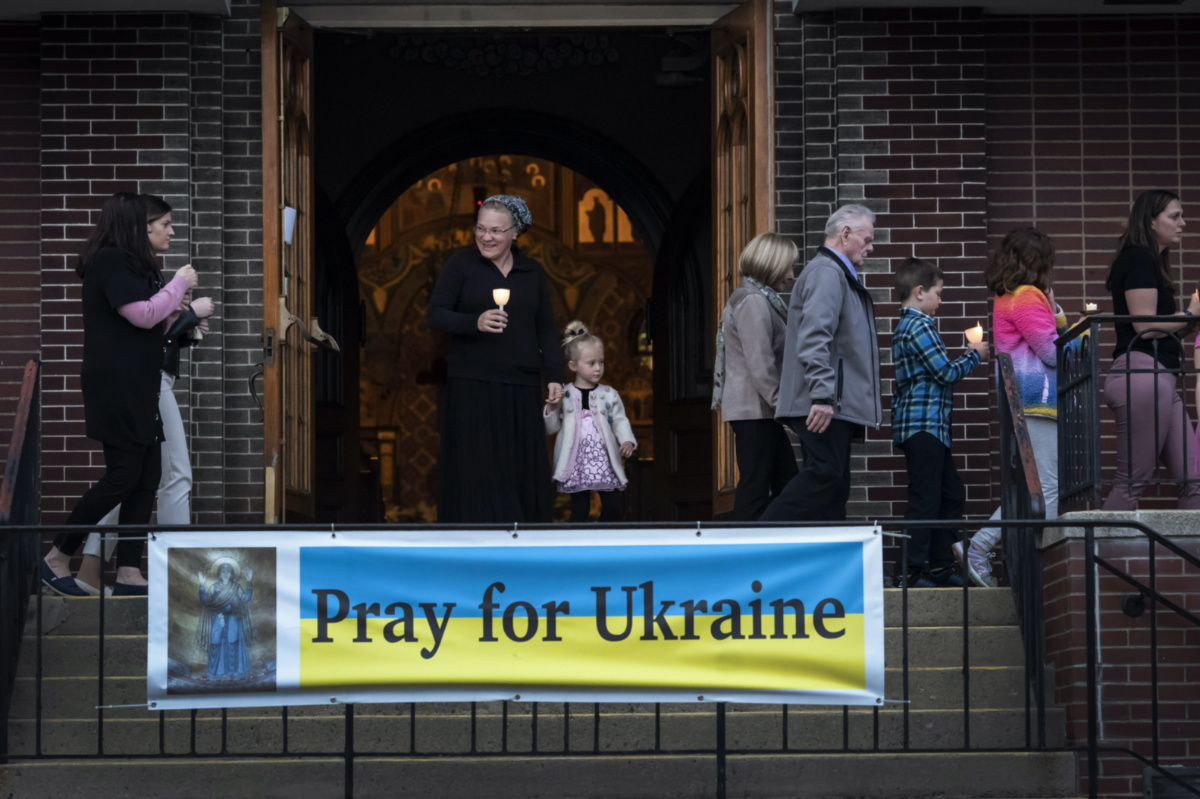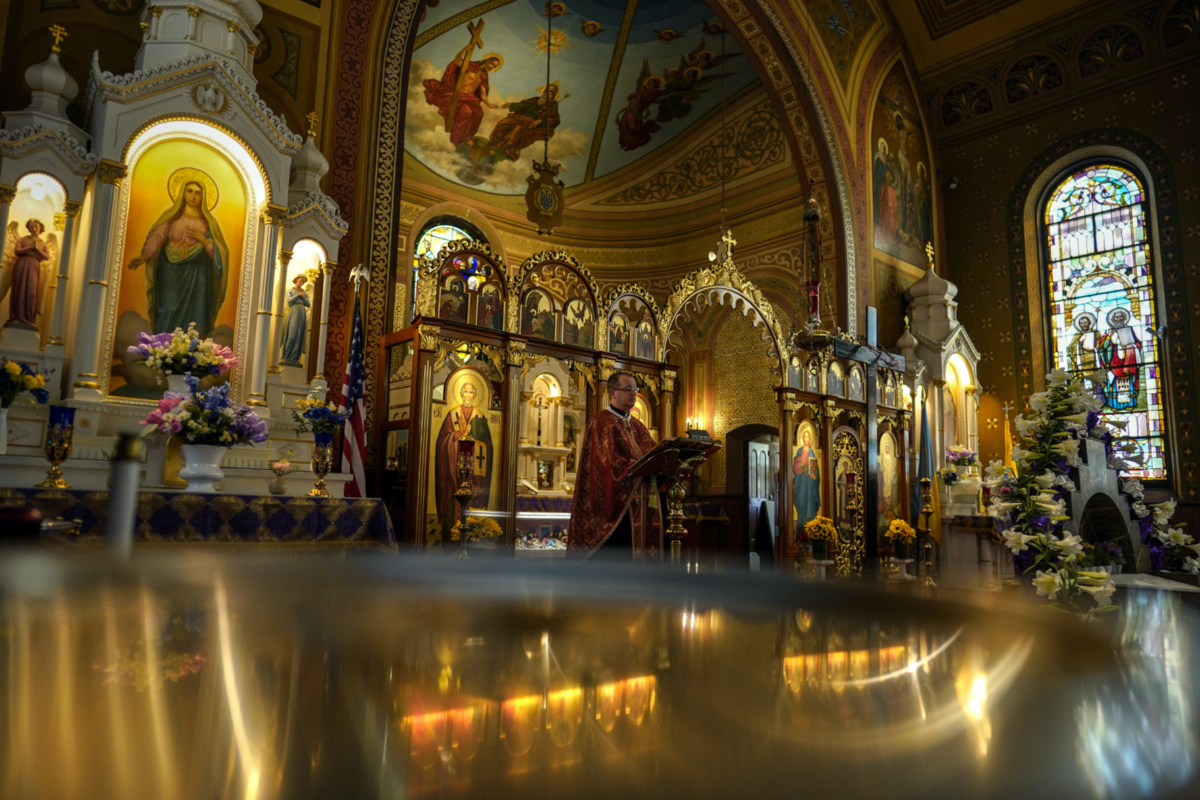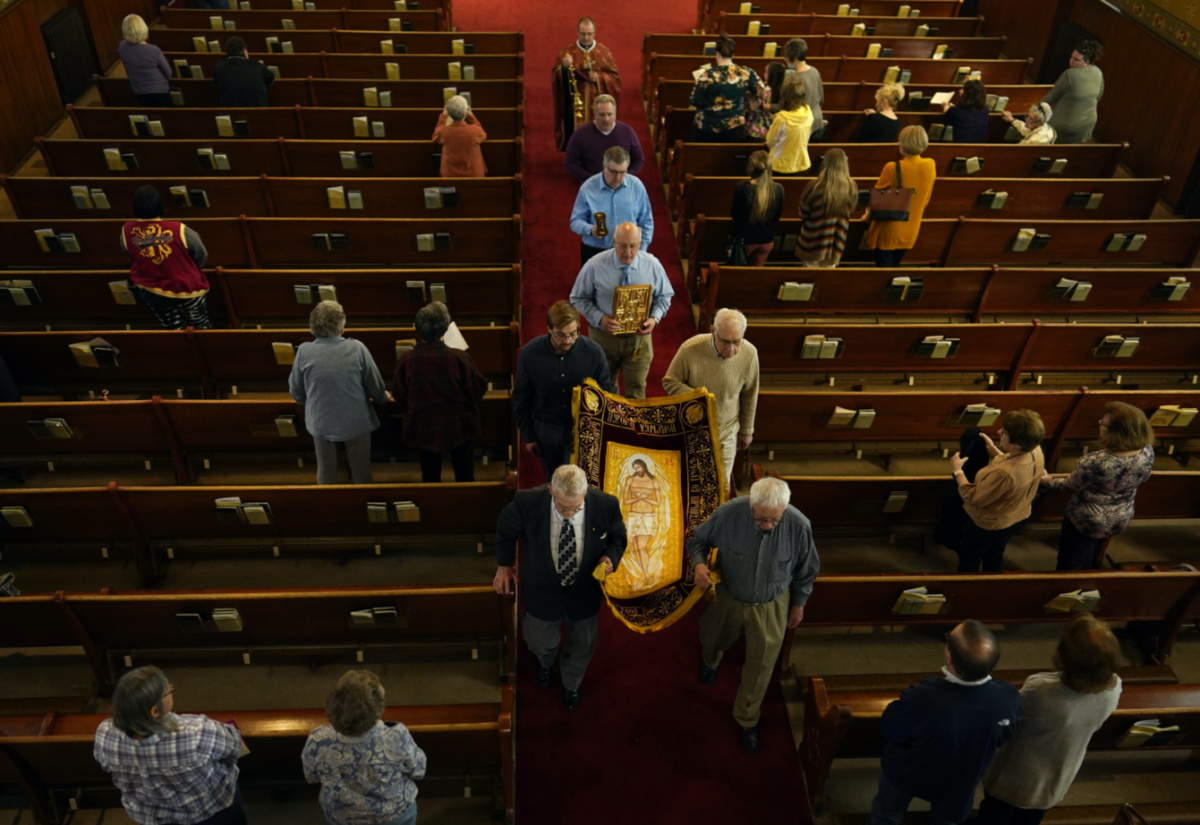The rituals leading up to Easter are the same. The solemn Good Friday processions. The Holy Saturday blessings of foods that were avoided during Lent. The liturgies accompanied by processions, bells and chants.
But while Easter is the holiest of holy days on the church calendar, marking the day Christians believe Jesus triumphed over death, many members of Ukrainian Orthodox churches across the United States are finding it difficult to summon joy at a time of war.

Parishioners walk in procession around the church, on Friday, 22nd April, during a Good Friday service at St Mary’s Ukrainian Orthodox Cathedral in Allentown, Paennsylvania. While Easter is the most joyous of holy days on the church calendar, marking the day Christians believe Jesus triumphed over death, many members of Ukrainian Orthodox churches across the United States are finding it difficult to summon joy at a time of war. PICTURE: AP Photo/Wong Maye-E.
Many are in regular contact with relatives or friends suffering amid the Russian invasion of Ukraine, which has laid waste to cities and claimed thousands of civilian lives, according to the Ukrainian government.
“This is a very strange Easter for us,” said Rev Richard Jendras, priest at St Mary’s Ukrainian Orthodox Cathedral in Allentown, Pennsylvania. “It should be a joyous holiday, and it’s all about new life, and yet here we are being confronted with the harbingers of murder and killing and genocide and death.”
Many believers “are walking around like zombies,” he said. “We are going through the motions of Easter right now because it’s what we have to hang on to.”
Orysia Germak, a member of the Ukrainian Orthodox Cathedral of St Volodymyr in New York City, said news from the war summons bad memories: She was born in a camp for displaced persons camp after her mother fled Ukraine post-World War II, she said.
“Easter is such a joyous occasion, but this underlines everything,” she said. “It’s surreal.”
Both cathedrals are part of the Ukrainian Orthodox Church of the USA, whose parishes include many people with recent or ancestral ties to the old country.
Most Catholics and Protestants celebrated Easter last Sunday, but Eastern Orthodox are celebrating this Sunday. They usually do so later than Western churches because they use a different method of calculating the date for the holy day, which they call Pascha.
Some Ukrainian Catholics, particularly in Ukraine itself, also are celebrating this Sunday. But many Ukrainian Catholics in the US celebrated last Sunday.
Among those celebrating Easter last weekend were congregants at Transfiguration of Our Lord Ukrainian Catholic Church in Shamokin, Pennsylvania, one of the oldest surviving Ukrainian Catholic churches in America.
Their priest, Rev Mykola Ivanov, 41, came from Ukraine in 2005. His elderly parents are in the city of Lviv, which has been thronged with refugees from elsewhere in Ukraine; his older brother is fighting with the Ukrainian army on the eastern front.

Fr Mykola Ivanov celebrates vespers and procession of the Holy Shroud on Good Friday at Transfiguration Of Our Lord Ukrainian Catholic Church, in Shamokin, Pennsylvabia, on Friday,15th April. AP Photo/Carolyn Kaster.
At every Mass since the war started, the service has included a “Prayer for Ukraine.” It includes a plea to God to crush the invaders who threaten the Ukrainians’ “precious Land.”
For Orthodox Ukrainians, Easter is being marked on both sides of the battle lines. Eastern Orthodoxy is the predominant religion in Ukraine and Russia, as well as in several neighbouring lands. A schism among Ukrainian Orthodox – with one group asserting independence and the other historically loyal to the patriarch of Moscow – has reverberated worldwide amid competing claims of legitimacy. But the two main Orthodox bodies in Ukraine have both fiercely opposed the Russian invasion.
In the United States, many people with ties to Ukraine are monitoring the war closely and sending funds to individuals and aid groups there, said Andrew Fessak, president of the board of trustees at St Volodymyr.
While Orthodox in America can celebrate freely, “our relatives and friends in Ukraine are under pressure from an invading army and aren’t as free to celebrate as they wish,” Fessak said. “They may not be able to get to churches. They may not be able to walk about town like they wish. They may not be able to have traditional foods they might have on Easter.”
And yet he takes heart in the strength of the Ukrainian resistance.
“The Ukrainian population has shown they are highly keen on retaining Ukrainian independence,” he said. “That’s at least a strong comfort to us, to see there is such a strong civic pride and sense of patriotism.”

Fr Mykola Ivanov, top center, members of the congregation and altar servers preform the procession of the Holy Shroud on Good Friday at Transfiguration Of Our Lord Ukrainian Catholic Church, in Shamokin, Pennsylvania, on Friday, 15th April, 2022. The Holy Shroud is taken outside around the church to symbolise the funeral procession of Christ to the grave. The Holy Shroud is a cloth depicting the Savior lying in the tomb. PICTURE: AP Photo/Carolyn Kaster.
Rev John Charest of St Peter & St Paul Ukrainian Orthodox Church in Carnegie, Pennsylvania, said it’s important to carry out the historic rituals even in somber times – in part to defy Russian President Vladimir Putin, who launched the war while claiming that Ukraine has no historic legitimacy apart from Russia. Ukrainians say they are a separate though related people group, with their own language and traditions.
Even though believers in the US may have “a feeling of survivor’s guilt,” they have a duty to continue traditions that are under such threat in Ukraine, Charest said.
“We do need to be strong now and we do need to be celebrating this feast,” he said. “If we’re not celebrating our traditions, that’s exactly what Putin wants.”
Jendras said the holy day offers a timeless message: “We have to look at the evil in front of us and say no, good does triumph and will always triumph.”
– With photographer CAROLYN KASTER in Shamokin, Pennsylvania.






